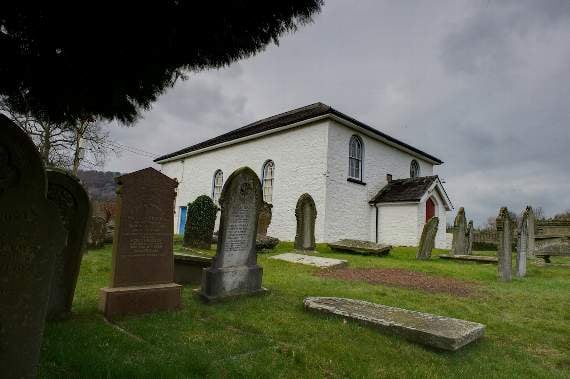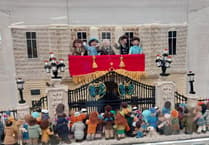FOR generations Llanover has been renowned for the stately splendour of its estate and the ‘Lady of the triple harp’, yet in 1921, this sleepy little corner of Britain became notorious for far more sinister reasons.
On October 26 of that year, the murderous mayhem and madness of the modern world would creep into the picturesque Monmouthshire village and leave in its foul wake a close-knit community unravelling with grief.
Chronicle reporter TIM BUTTERS delves into a dispiriting drama which revolves around a wandering tramp, a bloodthirsty bludgeoning, a forgotten funeral attended by thousands, and the tragic tale of the last ever man to be hanged at Usk Prison.
When the lazy autumn sun crawled sluggishly into the heavens on another routine October day in 1921, David and Margaret Thomas were busy about the early morning mundane chores common to couples throughout the land.
Little did either of them suspect, that one of them would not live to see another sunrise and the other would have their acute sense of loss compounded tenfold by being forced to confront the terrible vision of their beloved lying lifeless and limp after being battered senseless in an inexplicable act of brutality.
The hearty country breakfast of bacon and fried potatoes would be the last meal that Mr and Mrs Thomas would share as husband and wife in the brief 18 months of married harmony they spent living in Lapstone Cottage on the Llanover Estate.
Mere minutes after David kissed her goodbye and left for work at Ffawydden Quarry on that fateful morning, Margaret Thomas’s blood would run cold and her heart would beat no more.
The 48-year-old woman would be sent to the cold and dark of an early grave by a opportunistic tramp - a wandering chancer who had been observing the Thomas household with a grimly calculating eye, waiting for his chance to pounce and commit what the Abergavenny Chronicle of the time called ‘a most dastardly outrage.’
The tragedy unfolded when Margaret’s unsuspecting husband returned to his ‘fairy-tale cottage’ that evening to find the house shrouded in darkness and the front door bolted.
To add to his growing uneasiness, David noticed that the couple’s pigs had not been fed or released form the sty and the chickens were still in their coop.
His anxiety threatened to spill over into panic when he also noticed that one of the upstairs windows was mysteriously open,
Grabbing a ladder David climbed into the window and rushed into the engulfing gloom of the house only to find the bedroom had been ransacked.
With nerves taut with foreboding and a mouth as dry as a funeral drum, David immediately headed downstairs only to be confronted with the horror of horrors.
His wife of a year and a half was lying in a pool of congealed blood. Her body had been casually discarded amongst the general chaos of a looted kitchen whose contents had been littered in such a haphazard manner it now resembled more of a war zone than a haven of domestic bliss.
To complete this vision spewed forth from the mouth of Hades, Margaret’s head and face showed all too visible signs of the savage beating it had endured at the hands of an apocalyptic rage.
Her husband’s eyes were then drawn to an 18 inch blood encrusted iron bar which was lying stark and complicit next to the murdered woman’s body.
The sight of the murder weapon was all too much for the poor man’s heart and soul to bear. With his very essence devoured by grief and a mind stripped clean by sorrow, he ran screaming from a home whose happy memories had been obliterated by an unfathomable madness from the abyss.
In the wake of this terrible discovery, the neighbours were alerted, the police were informed, and a major man hunt was afoot.
It was declared to be of the utmost importance that the perpetrator of such a dastardly deed be caught forthwith.
When he came to his senses a day later, David told the Chronicle in words loaded with heartbreak, “My wife and I were a most happy couple and she was very cheerful when I left for work that morning.
“When I returned in the evening I noticed that the blinds were drawn downstairs and the front door was locked.
“A strange feeling came over me, I thought that something must have happened to my wife.
“When I eventually entered the kitchen I saw the ghastly sight of my beloved lying on her face and there was blood all over everything.
“There was a heavy bolt near her body with a nut rivetted at the end. It was the sort of thing they use on the railway.”
The heartbroken husband was then reported to have broken down in tears, before wiping his eyes and adding, “You don’t mind me crying do you? I can’t help it. All last night I could hear her crying to me, ‘Dai, Dai!’ But I knew she would never speak again. The poor little thing had no chance to cry out.
“She had hardly finished her breakfast. The things were still on the table and there was still some tea in the cup. She was a little woman and what could she do against a man?”
Although, amongst other things, a blue suit and a pair of boots had been stolen from the house, the police at the time seemed to concur that the murder was probably not premeditated and was due to some outburst of ‘elemental passion’.
Near the scene of the murder was found a ‘tea jack’, which was described as the kind usually used by the ‘tramping fraternity.’
This, coupled with the fact of numerous reports of a strange man loitering in the vicinity of Lapstone Cottage in the two weeks prior to the murder, seemed to point the finger of blame quite firmly at a ‘gentleman of the road’.
In the days after the murder, rumours circulated about a vagrant seen in the area ‘foaming at the mouth’, but this was dismissed as ‘fantastic’ by police who eventually succumbed to public pressure and arrested a 62-year-old tramp by the name of James Coghlin.
Coghlin was released from custody a few days later without charge to cries of despondency amongst the public and media who formed a general consensus that the Lapstone cottage murder would probably be added to the long list of unsolved crimes.
By the time of Margaret’s funeral four days later on October 30, her killer was still at large and her death still called for its rightful balance on the unwavering and eternally patient scales of justice.
Her funeral was said to attract ‘remarkable scenes’ with people coming from far and wide to pay tribute. The lane which runs past Lapstone cottage was reported to be packed from one end to the other with over three thousand people.
The funeral was held in Goytre’s Saron Baptist Church and was attended by the owners of Llanover Estate - Lord and Lady Treowen.
At the service, the minister said of the murderer, “If this man whoever he was, shall escape the judgement of our law, there is a judgement which he shall never escape.”
Nineteen days later on Friday, November 18, a 42-year-old man was arrested on the mountainside above Cwmbran. His name was William Sullivan and he was described as a ‘native of Cwmbran, but of vagrant habits’.
At his appearance at Pontypool Magistrates he was described by the Chronicle as, “A very thick-set man, a few inches over five feet in height with strongly marked features and almost white hair.”
It was reported that as the prisoner left the dock he was said to glance at the ground and smile.
Although Sullivan pleaded not guilty from the point of arrest to his eventual sentencing the evidence against him was quite damning.
It later transpired during his trial at the Monmouthshire Assizes on February 8, 1922, that Sullivan was seen by a succession of witnesses in the location of Lapstone cottage a short time prior to the murder of Margaret Thomas.
The prosecution also proved that Sullivan had attempted to sell the suit of clothes and boots formerly belonging to David Thomas and which were taken from the cottage on the day of the murder.
The most incriminating testimony however, came from Sullivan’s own brother and brother-in-law who told the court how they had met Sullivan on the afternoon of the murder in Cwmbran’s Forge Hammer Inn, where the accused bought them three pints of beer each.
A Chronicle reporter wrote at the time, “It is a very peculiar thing that a man of the tramping class who travelled from workhouse to workhouse should appear at the Forgehammer in Cwmbran and treat his relatives to drink in such a lordly manner.”
When questioned, Sullivan remained vague and claimed he had earned the money in the employment of a woman he could neither remember the name or address of.
During the trial it also came to light that Sullivan had served in the army since 1901 and was honourably discharged in 1909. Since then he had not had regular employment and journeyed from one workhouse to another.
On February 9 the jury retired for two and a half hours before returning with a verdict of ‘Guilty of the wilful murder of Margaret Thomas.’
Mr Justice Darling passed the death sentence as a pale and haggard looking Sullivan was marched away.
Condemned to the cold care of the angel of death, a terrified Sullivan exclaimed loudly in desperation, “I am not guilty, and have always said so!”
Sullivan’s appeals were created with a stony silence by all in the packed courtroom as they fell futile and forsaken from his lips.
On March 22, the renowned executioner John Ellis, who would cut his own throat with a razor ten years later because of his experiences as a hangman, arrived at Usk prison.
The very next morning Sullivan was given the rare distinction of becoming the last ever
person to be lynched in Monmouthshire.
The condemned man’s body fell through the trapdoor and his spirit into the gaping jaws of hell at exactly 8.am.
Justice was declared done and the gathered crowd dispersed.
THIS STORY WAS FIRST PUBLISHED IN THE ABERGAVENNY CHRONICLE IN MARCH 2011





Comments
This article has no comments yet. Be the first to leave a comment.